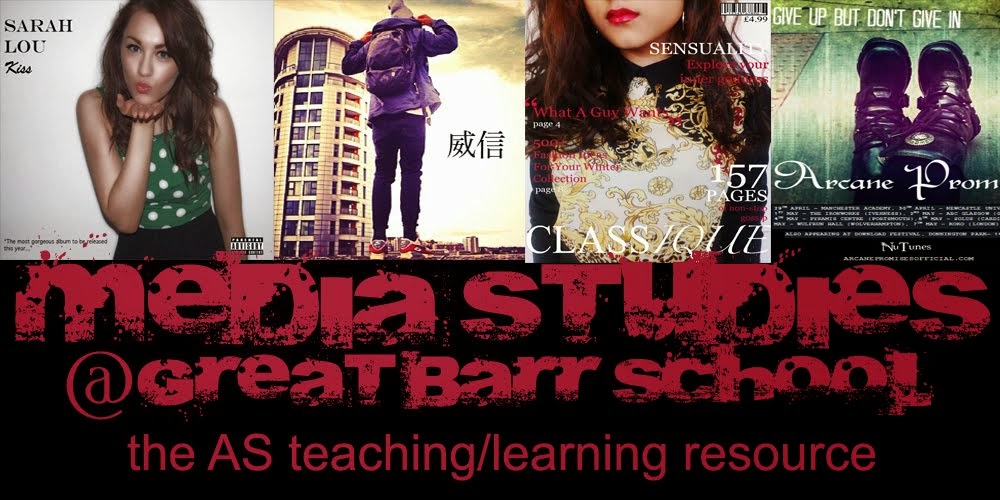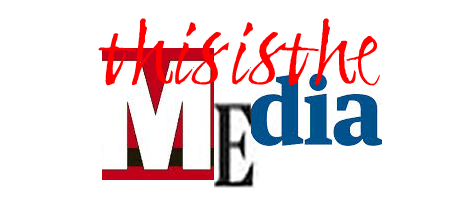Dear all
following so many requests from those of you in the lessons, I'm publishing the PowerPoint for the 'Charity Campaigns' lesson. Thanks for all of the positive feedback to this lesson. Please use the resource for revision on ideologies and application of theories to texts and think about the issues raised on slide 14. In the lesson we talked about how these texts might be used in exploring the media theories we've been working through :
Hall [Encoding/Decoding],
Morley [reception theory]
Blumler and Katz [Uses and Gratification]
McComb and Shaw [agenda setting and framing/re-framing]
media studies

student work 2012/14
Thursday 27 February 2014
Wednesday 12 February 2014
Dermablend Go Beyond the cover explained
Dermablend, the L'Oréal-owned cosmetics brand hired Rick Genest, perhaps the world's most recognizable full-body canvas, to star in its new spot from Montreal agency Agence Tuxedo—to prove just how well its makeup can conceal anything.
Better known as Zombie Boy, the undead-obsessed model has covered the majority of his person with tattoos meticulously designed to make him look like a walking, decomposing corpse. He's landed roles in Lady Gaga's "Born This Way" video and a campaign for fashion brand Mugler, raising the public profile of his persona. But the Dermablend spot opens with Genest looking less maggot-infested—just another boring, brooding white guy with some metal in his face. Staring into the camera while trying fiercely to look defiant, he strips off his shirt and proceeds to engage in a stilted, ritualistic cleansing. First, he scrubs a layer of cover-up off his sternum. Then he rubs his face with a towel. With the help of a little video editing, his more familiar grinning-skull visage emerges from behind the cloth, and the ad launches into a reverse-time lapse, revealing a gaggle of artists painting Zombie Boy normal.
It's solid, if somewhat strange, viral stunt that's drawn attention to a brand that at its core isn't all that exciting. But Genest and the visual effect largely eclipse the brand message, which is itself a bit vague. "How do you judge a book?" asks the copy. "Go beyond the cover." Ah, the inner-beauty aphorism. That seems a bit self-defeating for a product whose existence depends on vanity.
Go Beyond the Cover: representations
A very cool advert from Dermablend to supplement our work on revising representations over the next few sessions.
Enjoy
Go Beyond The Cover - Official Video (Agence TUXEDO) from Agence Tuxedo on Vimeo.
Enjoy
Go Beyond The Cover - Official Video (Agence TUXEDO) from Agence Tuxedo on Vimeo.
Tuesday 4 February 2014
Super-Bowl Advertising
Experts
call it fragmentation. TV shows no longer attract big audience that once made
mass marketing possible, so advertisers lost faith in making big budget
emotional spectaculars to move the general public. Critics called Breaking Bad
the greatest show of all time, but fewer than 3% of Americans actually watched
it.
The
Super Bowl is the exception. As we have
noted, more than a hundred million Americans come together to watch the game.
And a hundred million viewers glued to their TVs for four hours is a big deal
for advertisers. As we have seen, the airtime alone costs $4m for 30 seconds. Many advertisers budget a further $4-6m to preview their spots on YouTube and promote them on Twitter. They have staffed social media command centers with sitcom writers to talk their way into the online conversation and spin it the way of the advertisers and their client. Add the cost of shooting special effects and hiring the star name or director and the fifty advertisers who appear in the Super Bowl have staked half a billion dollars on a night’s popularity.
Some struck early. This was the first Super Bowl where the ads were already in the public domain weeks in advance of the event. Budweiser racked up close to 20m YouTube views of their Super Bowl spots before game time.
Sodastream: Banned Super-bowl advert: the issues
Scarlett Johansen’s Soda stream advert was banned because of its jokey, disrespectful reference to Coke and Pepsi who are both significant and substantial sponsors of the Super-bowl and of American football.
The reaction prompts a
number of issues:
- Did Soda stream know the reaction/response and seek such publicity by creating a controversy – the advert has attracted millions of YouTube hits as well as pages and pages of newspaper coverage and Facebook, Twitter and blogger commentaries. Millions of dollars’ worth of free publicity.
- The swift banning indicates the protective attitude of brands to their images – would such a joke have dented the sales of Coke and Pepsi?
- Do Soda stream come off as being much edgier and thus of wider youth market appeal as a result of their tongue in cheek advert? Remember, this is a product that was for many years associated with traditions such as soda siphons and whiskey and soda rather than a cool modern refreshment brand. How do Coke and Pepsi look – maybe a little insecure if they are frightened of the impact of one jokey advert on their powerful brand identity?
- The power that brands can exert over media institutions – who would want to offend these giants of advertising spending [each of these giants spent over $2 billion dollars each in America in 2012 advertising their brands] if it meant them threatening to take their advertising money elsewhere?
- The increasing influence of the internet and social media – despite being banned the advert was still seen by millions on YouTube days before Super-bowl and so dominated much of the traditional media coverage. In this sense, is social media setting the agenda? [Have a think about McComb and Shaw here].
- The fact that adverts are viewed as news by the big media institutions. NBC have a 30 minutes feature each Super-bowl devoted to running previews of the ads and interviewing the celebrities involved in them - treating them as if they were movies.
- The status of the advert – or the paycheck – attracts luminaries to feature in their creation. This season’s super-bowl featured adverts directed by ‘A’ list directors such as Tom Hooper [The King’s Speech/Jaguar], Jake Ridley-Scott [Budweiser], Nicholas Winding Refn [Drive/H&M] and actors - Scarlett Johannsen, Anna Kendrick, Laurence Fishburne, Tom Hiddleston, Ben Kingsley, Mark Strong.
Monday 3 February 2014
A little bit of revision...
Dear all
A little bit of revision for those of you who just can't get enough of rehearsing the knowledge and understanding assessment objectives found in MEST1 Section A.
Have a look at the advert for Jaguar cars premiered at the Superbowl Feb.2014.
It was directed by Tom Hooper [The King's Speech] and features an 'A' list cast of British actors - Ben Kingsley, Mark Strong and Tom Hiddleston. The advert plays on the current vogue for Hollywood's tendency to cast British actors as the villain in their films. It's an excellent way of underlining the car's credentials for a global market that at present seems to have quite an appetite for a certain kind of Britishness.
A little bit of revision for those of you who just can't get enough of rehearsing the knowledge and understanding assessment objectives found in MEST1 Section A.
Have a look at the advert for Jaguar cars premiered at the Superbowl Feb.2014.
It was directed by Tom Hooper [The King's Speech] and features an 'A' list cast of British actors - Ben Kingsley, Mark Strong and Tom Hiddleston. The advert plays on the current vogue for Hollywood's tendency to cast British actors as the villain in their films. It's an excellent way of underlining the car's credentials for a global market that at present seems to have quite an appetite for a certain kind of Britishness.
- How does the text use media language to put forward the idea of Britishness?
- How are Brits represented?
- Why might they choose to use this technique to promote the car?
Subscribe to:
Posts (Atom)
